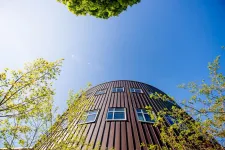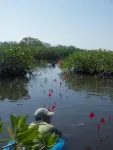What early-budding trees tell us about genetics, climate change
2021-03-22
(Press-News.org) One of the surest signs of spring is the vibrantly lime-green tinge trees develop as their buds open and tiny new leaves unfurl. Bud-break is the scientific name for this process -- a straightforward term for the grand genetic mechanism that allows trees to leaf out and do their summer work of photosynthesis to store up energy for the coming winter.
Bud-break is precluded by bud-set, which occurs in the autumn. After trees have dropped their leaves and as the days shorten and grow colder, new buds grow on branches. Like many wildflowers, trees require a period of dormancy at colder temperatures -- a process fine-tuned by evolution -- before bud-break can occur.
But as the changing climate becomes increasingly unpredictable, late frosts are more common -- and many trees initiate bud-break too early or too late. For farmers who grow fruit- and nut-bearing trees as well as grape vines, a mistimed bud-break and a frost could mean the difference between a good harvest and none at all.
For example, a late frost in 2007 across the eastern U.S. resulted in an estimated agricultural loss of $112 million, including $86 million in losses to fruit crops. Poorly synchronized bud-break can also lead to pest and disease outbreaks.
Understanding bud-break genetics enables scientists to modify or select crop varieties more resilient to such threats.
Victor Busov, professor in the College of Forest Resources and Environmental Science at Michigan Technological University, along with colleagues in the U.S. and Sweden, published new research about the transcription factors responsible for early bud-break in the journal Nature Communications. Transcription factors are genes that regulate other genes by binding to DNA and giving activation instructions.
Regulating Bud-break
The properties of transcription factors help scientists determine what other genes might be involved in a particular process like starting bud-break.
Busov and collaborators previously identified transcription factors for early bud-break 1 (EBB1) and short vegetative phase-like (SVL), which directly interact to control bud-break. The research team has now identified and characterized the early bud-break 3 (EBB3) gene. EBB3 is a temperature-responsive regulator of bud-break controlled by interactions between genes and the surrounding environment. The transcription factor provides a direct link to activation of the cell cycle during bud-break.
"We know now EBB3 is providing a direct link through the signaling pathway for how these cells divide," Busov said. "Once we found the third gene, we started to put them together in a coherent pathway, which helps us see the bigger picture."
Using poplar and flowering locus trees in the Michigan Tech greenhouses, the researchers mimicked the daylight length and temperature of an average summer day for a period of time, followed by a period that mimicked average winter days. Then, the scientists conducted gene expression analysis to determine how the transcription factors worked together to help the trees judge when to put forth leaves in the greenhouse's artificial springtime.
Busov said the analysis reveals how particular genes activate through the season or in response to specific environmental factors.
"We need to understand not only three transcription factors, but the whole network," Busov said. "Once we identify the genes, we do experiments where we dial up or down the expression of the gene. We look at what the effect of these actions is on offspring. Identifying variation in the network will allow us to regulate early bud-break. New technologies of sequencing are empowering these areas."
Speaking for the Trees
The climate has profound effects on the genetic processes that regulate bud-break. The first of these effects is warming winters. In places that no longer experience enough cold, trees do not get the necessary growth-resetting cold exposure. Cold exposure is crucial for strong and uniform bloom and leaf-out, which is needed to produce a good crop, whether it's peaches, apples, cherries, grapes or almonds.
The second way climate change affects trees is late frosts. Bud-break is all about timing; trees shouldn't initiate leaf growth until the danger of frost is past. Instances of extremely late frost are becoming more common, and as Busov notes, research indicates that the frequency of these events is increased by climate change.
"Late frost has detrimental effects, not only on fruit trees, resulting in crop loss, but also forest trees," Busov said. "Frost negatively affects growth and inflicts injuries to growing organs, making trees susceptible to disease and pests."
To make matters worse, trees are such long-lived organisms that their evolution is not keeping pace with the rate at which the climate is changing.
"For trees, their adaption is generational - but their generations are so long, their adaptation is also so long," Busov said. "You need some way to speed this up, both in fruit trees and in forest populations. With rapid changes, there is no time for this adaptation."
Devising new approaches for accelerated tree adaptation to climate change can ensure bud-break happens at precisely the right time each spring. Using their understanding of the genetic pathways that control bud-break, scientists hope to genetically modify crops to adapt to warmer winters and unpredictable frosts. Scientists can also conduct genome-assisted breeding -- the age-old process of natural selection, with science-enabled knowledge.
INFORMATION:
Collaborators: Abdul Azeez (Michigan Tech), Yiru Chen Zhao (Michigan Tech), Rajesh Kumar Singh (Swedish University of Agricultural Sciences, CSIR-Institute of Himalayan Bioresource Technology), Yordan S. Yordanov (Michigan Tech, Eastern Illinois University), Madhumita Dash(Michigan Tech), PalMiskolczi (Swedish University of Agricultural Sciences), Katja Stojkovič (Swedish University of Agricultural Sciences), Steve H. Strauss (Oregon State University) and Rishikesh P. Bhalerao (Swedish University of Agricultural Sciences).
[Attachments] See images for this press release:

ELSE PRESS RELEASES FROM THIS DATE:
2021-03-22
DURHAM, N.C. -An unfortunate biological "feed-forward" loop drives cartilage cells in an arthritic joint to actually contribute to progression of the disease, say researchers at Duke University and Washington University in Saint Louis.
Pain researcher and mechanobiologist Wolfgang Liedtke, a professor of neurology at Duke, partnered with former Duke colleague and cartilage expert Farshid Guilak, now at the Washington University School of Medicine, to examine the activity of pressure-sensitive ion channels in cartilage. Their study appears the week of March 22 in the Proceedings of the National Academy of Sciences.
Cartilage is the highly lubricated, low-friction, elastic tissue that lines ...
2021-03-22
There are 12 essential attributes that explain why commercial carbon capture and sequestration projects succeed or fail in the U.S., University of California San Diego researchers say in a recent study published in Environmental Research Letters.
Carbon capture and sequestration (CCS) has become increasingly important in addressing climate change. The Intergovernmental Panel on Climate Change (IPCC) relies greatly on the technology to reach zero carbon at low cost. Additionally, it is among the few low-carbon technologies in President Joseph R. Biden's proposed $400 billion clean energy plan that earns bipartisan support.
In the last two decades, private industry and government have ...
2021-03-22
Amsterdam, NL, March 22, 2021 - The COVID-19 pandemic has had a profound impact on our world, with disequilibrium, uncertainty, and human suffering making it difficult to envision a human, societal and individual future. Milan Zeleny, PhD, Professor Emeritus of Management Systems, Fordham University, New York, NY, USA, and world-recognized authority on decision making, productivity, knowledge management, and more recently the corporation as a living organism, says that "COVID-19 is rapidly changing from a cause to one of the symptoms of an increasingly unhinged world."
Writing in the journal Human Systems Management, published ...
2021-03-22
A University of New Mexico research team conducted a data analysis that has found that as a larger portion of the population gets vaccinated against COVID-19, it becomes economically advantageous to start relaxing social distancing measures and open businesses.
Francesco Sorrentino, associate professor of mechanical engineering, is lead author of "Data-driven Optimized Control of the COVID-19 Epidemics," published March 22 in Scientific Reports.
Co-authors of the study are Afroza Shirin of the Department of Mechanical Engineering and the Department of Electrical and Computer Engineering, and Yen Ting Lin, a staff scientist of the Information Science Group in the Computer, Computational ...
2021-03-22
Despite the fact that viruses are among the simplest biological entities--consisting only of DNA or RNA encapsulated in a protein shell--they can have devastating consequences, with viruses such as influenza, human immunodeficiency virus (HIV), and Ebola having dramatically affected the course of human history. Because they generally lack the cellular machinery necessary to reproduce, they propagate by hijacking host cells, often to the host's detriment. While their status as a "living" organism may be in question, there is no doubt that viruses are shaped by evolutionary forces that influence their genomes, as well as their replication, host range, virulence, and other features. With the emergence of ...
2021-03-22
The same process that drains the battery of your cell phone even when it's turned off is even more of a problem for lithium-metal batteries, which are being developed for the next generation of smaller, lighter electronic devices, far-ranging electric vehicles and other uses.
Now scientists at Stanford University and the Department of Energy's SLAC National Accelerator Laboratory have taken the first atomic-scale look at how this process, called "calendar aging," attacks lithium-metal anodes, or negative electrodes. They discovered that the nature of the battery electrolyte, which carries charge between the electrodes, has a big impact on aging - a factor that needs to be taken into account ...
2021-03-22
The first documented record of salt as an ancient Maya commodity at a marketplace is depicted in a mural painted more than 2,500 years ago at Calakmul, a UNESCO World Heritage site in the Yucatan Peninsula in Mexico. In the mural that portrays daily life, a salt vendor shows what appears to be a salt cake wrapped in leaves to another person, who holds a large spoon over a basket, presumably of loose, granular salt. This is the earliest known record of salt being sold at a marketplace in the Maya region. Salt is a basic biological necessity and is also useful for preserving food. Salt also was valued ...
2021-03-22
Two new environmental policy briefings, aimed at decision makers working on rapidly expanding urban areas in southern Africa, emphasise that local community voices must be included in the early planning stages to minimise ecological impacts.
Urban populations across the African continent and in particular the surrounding areas of urban sprawl, are forecasted to triple by 2050, resulting in higher rates of land conversion that have implications for managing significant environmental changes that lie ahead.
This expansion is happening faster than infrastructure changes can keep-pace, meaning that residents do not have access to important services to reduce the impact of climate-related events such as flooding, droughts, and heat-stress.
A new policy briefing, led by ...
2021-03-22
RIVERSIDE, Calif. -- A University of California, Riverside, study analyzing fourth-generation electronic cigarette, or EC, pod atomizer design features has found the pod atomizers are similar to those of previous generations and contain elements that may adversely affect health and accumulate in the environment.
EC atomizers are chambers that hold nicotine-containing fluid and upon heating generate an aerosol. The pod-style e-cigarettes have become very popular, especially with young people.
The elements/metals in atomizers are important because chronic exposure could adversely affect human health. Further, EC pod products, which eventually enter the environment, could ...
2021-03-22
Suppose you drop your morning coffee and it splatters everywhere. Later a colleague drops by to say hello. Do you grumble a testy acknowledgment, or cheerfully greet her?
In a new study on brain activity led by University of Miami psychologists, researchers found that how a person's brain evaluates fleeting negative stimuli--such as that dropped cup--may influence their long-term psychological well-being.
"One way to think about it is the longer your brain holds on to a negative event, or stimuli, the unhappier you report being," said Nikki Puccetti, a Ph.D. candidate in the Department of Psychology ...
LAST 30 PRESS RELEASES:
[Press-News.org] What early-budding trees tell us about genetics, climate change




